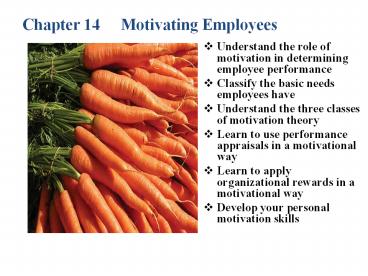Chapter 14 Motivating Employees - PowerPoint PPT Presentation
Title:
Chapter 14 Motivating Employees
Description:
Chapter 14 Motivating Employees Understand the role of motivation in determining employee performance Classify the basic needs employees have – PowerPoint PPT presentation
Number of Views:987
Avg rating:3.0/5.0
Title: Chapter 14 Motivating Employees
1
Chapter 14 Motivating Employees
- Understand the role of motivation in determining
employee performance - Classify the basic needs employees have
- Understand the three classes of motivation theory
- Learn to use performance appraisals in a
motivational way - Learn to apply organizational rewards in a
motivational way - Develop your personal motivation skills
2
Motivation in the P-O-L-C Framework
3
- Basic Motivation Elements
4
? Major Motivation Theories
Class of Motivation Theories Specific Theory (Creator)
Need - Content motivation theoriesfocus on identifying and understanding employees needs Hierarchy of needs theory (Maslow) proposes that employees are motivated by five levels of needs physiological, safety, social, esteem, and self-actualization. ERG theory (Alderfer) proposes that employees are motivated by three needs existence, relatedness, and growth. Two-factor theory (Herzberg) proposes that employees are motivated by motivators (higher-level needs) rather than by maintenance factors (lower-level needs). Acquired needs theory (McClelland) proposes that employees are motivated by their need for achievement, power, and affiliation.
5
(No Transcript)
6
(No Transcript)
7
Two Factor TheoryFrederick Herzberg
8
Acquired Needs Theory David McClelland
9
? Major Motivation Theories (contd)
Class of Motivation Theories Specific Theory (Creator)
Process motivation theories focus on understanding how employees choose behaviors to fulfill the needs. Equity theory (Adams) proposes that employees will be motivated when their perceived inputs equal outputs. Goal-setting theory (Locke) proposes that achievable but difficult goals motivate employees. Expectancy theory (Vroom) proposes that employees are motivated when they believe they can accomplish the task and the rewards for doing so are worth the effort.
10
Equity Theory (Adams)
Self Referent Other Outcomes
Outcomes Inputs Inputs
11
Expectancy Theory (Vroom)
12
(No Transcript)
13
? Major Motivation Theories (contd)
Class of Motivation Theories Specific Theory (Creator)
Reinforcement theory (Skinner) proposes that the consequences of behavior will motivate employees to behave in predetermined ways. Types of reinforcement Positive reinforcementis offering attractive consequences (rewards) for desirable performance to encourage the continuation of that behavior. Negative reinforcementis threatening to provide negative consequences for poor performance to encourage desirable behavior. Punishmentis providing an undesirable consequence (punishment) for an undesirable behavior to prevent the behavior. Extinctionis the withholding of reinforcement for a particular behavior.
14
Reinforcement Methods
15
(No Transcript)
16
- Job Specialization - the breaking down of tasks
to their simplest components - Proposed to minimize waste by identifying the
best method to perform the job
17
(No Transcript)
18
(No Transcript)
19
Alternatives to Job Specialization
20
(No Transcript)
21
(No Transcript)
22
(No Transcript)
23
Guidelines for Giving Feedback in a Performance
Appraisal Meeting































